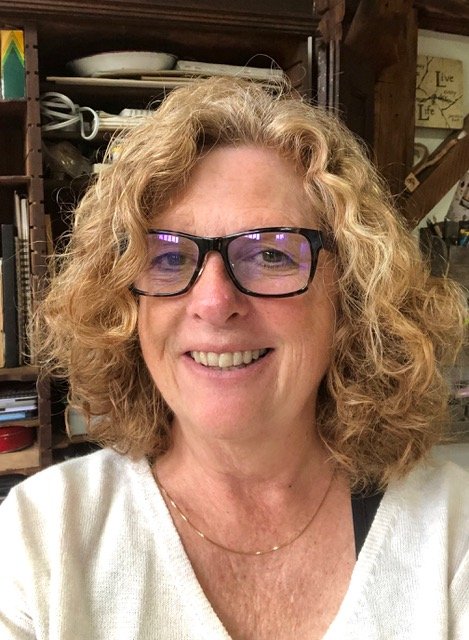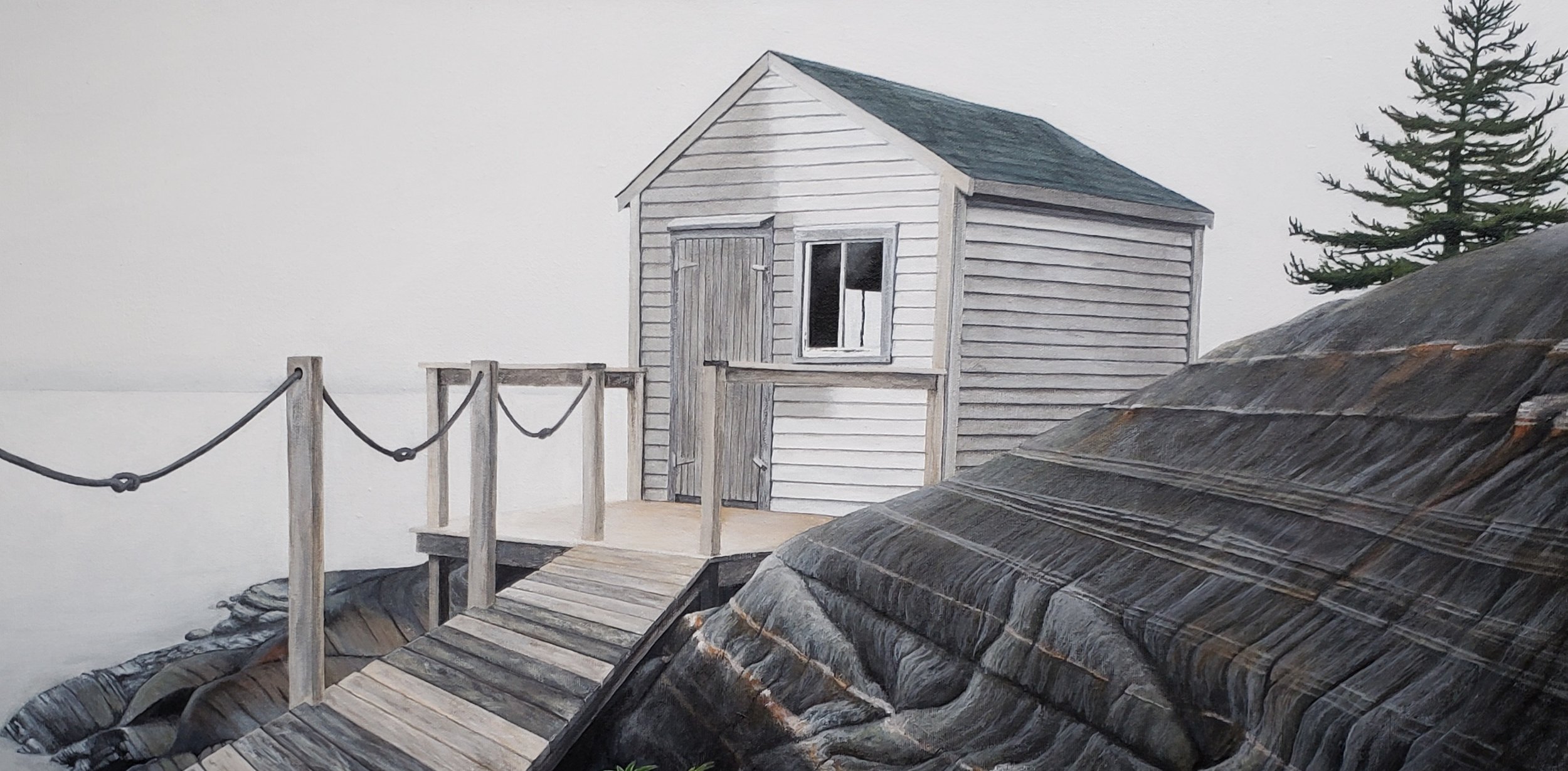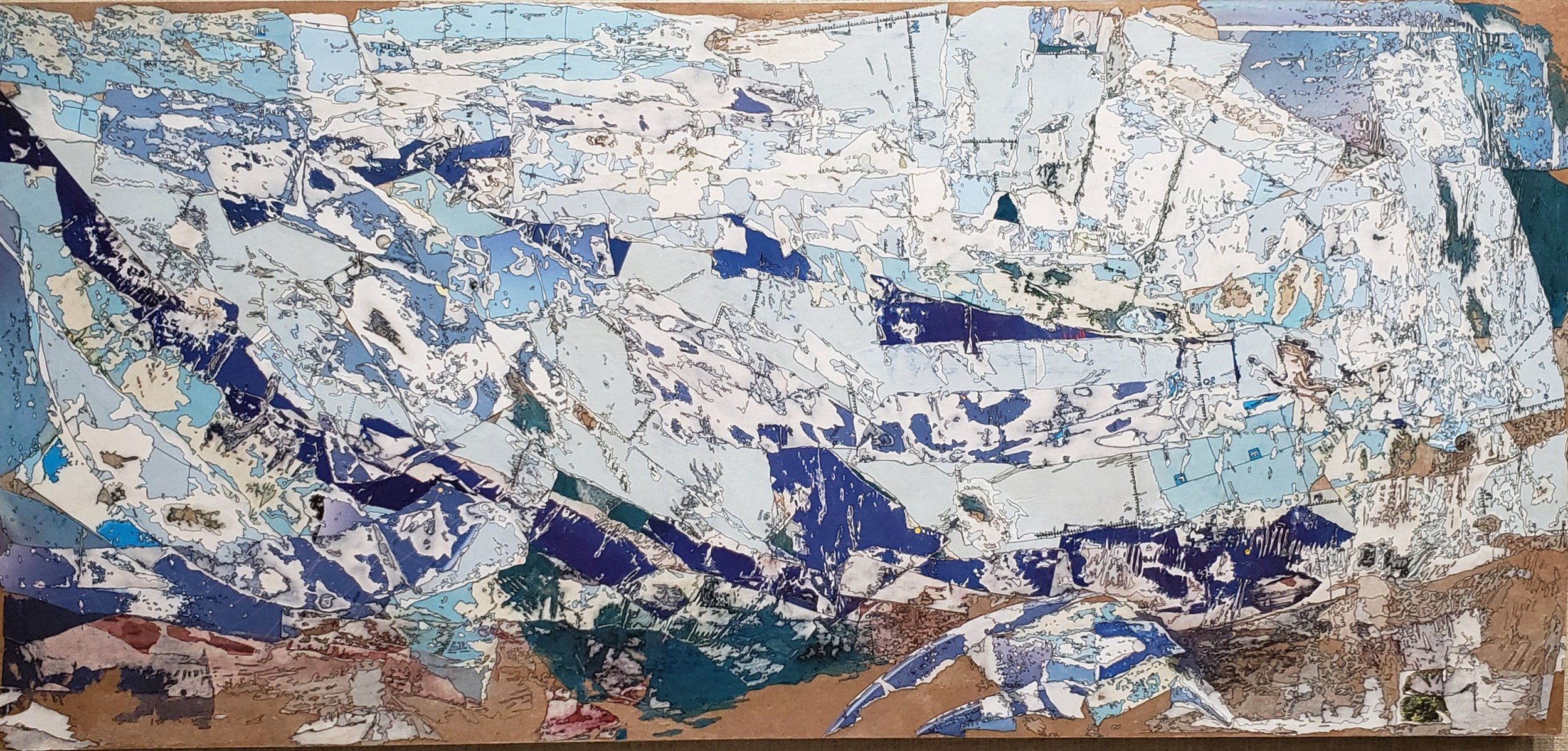Meet the Jurors
Meet the Winners
Comments from the Jurors
Paul Marshall
The collection of work in the exhibit featured a wide range of landscapes, methods and materials. The overall quality within this variety was both impressive and inspiring.
Some featured radical interpretations of landscapes, others radical uses of materials and processes, while others featured landscapes that were radical in and of themselves.
The works that caused the panel of jurors to pause, featured fresh approaches to interpreting landscapes. They invited us to imagine processes, narratives, and moments in time that took us from the Gallery and into these landscapes.
Congratulations to all of the participants and winners.
The Jury's Choice winner Kristina Flindall's submission 'Vulnerable' captured our attention. It combines impressive technical explorations with a scene that invites imagined narratives. All of this is achieved with a captivating balance of visual restraint and intricate explorations of detail.
Vincent Luk
I love all the different styles/mediums of all the submissions. Lots of great works of art with interesting interpretations of 'Radical Landscapes'.
The selected works for Award of Excellence show a diversity of styles and medium that I feel encapsulates the whole exhibition.
The Jury's Choice Award stood out with excellent lines/details on the rock, with a moody foggy scene. The subtleness of the white and grey with a touch of green, blends together beautifully transporting the viewer onto the boardwalk.
Amazing work by all who submitted.
Lesley Drummond
The scope of the work submitted made it both a treat and a challenge to jury.
A huge variety of media and approaches to the subject matter are evident with a phenomenal technical skill exhibited throughout the submissions.
There was a great deal of discussions by all four jurors when it came to narrowing down the list of finalists. A thoroughly enjoyable process for us which served to open our eyes even further to the merits of the artworks.
A fabulously high quality exhibit which will be a pleasure for everyone to view!
David Beaucage Johnson
All the pieces are of a really high caliber!
The 'Radical' theme was well thought out by each artist and became provocative, for as there is no evidence of fear of colour, pieces without colour showed innovative composition and attention to evoke emotion. The range of mediums is impressive and the artists approached each piece with maximum effort and professionalism.
Additional Information
Being radical is defined as, the relating to or advocating for revolutionary changes.
-
‘In 1911 a group of Canadian artists were drawn together by a common sense of frustration with the conservative quality of Canadian art, rebelling against the constraints of 19th-century naturalism.
In this atmosphere, a group of painters and commercial artists befriended each other in Toronto between 1911 and 1913. They were drawn together by a common sense of frustration with the conservative quality of most Canadian art. They began meeting as a kind of mutual support group, often having lunch together at the Arts and Letters Club of Toronto where they would look at one another’s paintings, share ideas and discuss technique.
The members of the Group were not exclusively landscape painters.
It was only after their first exhibition on May 7, 1920, at the Art Gallery of Toronto (now the Art Gallery on Ontario that they began to identify themselves as a landscape school.
The members of the group were romantic, with mystical leanings. They zealously presented themselves as Canada’s first national school of painters. This provoked the ire of the artistic establishment, which hated their rhetoric even more than their paintings.
From the start, the Group’s exhibitions sparked controversy. (One review of their first exhibition compared the works to “the contents of ‘a drunkard’s stomach.’”)
If anything, it was this heated debate that kick-started their fame.
The negative reviews and letters to the editors received clever and passionate responses from the painters and their supporters. The discussion was always directed to the importance of their work as the product of true nationalistic expression.’
Article by Christopher Varley, Russell Bingham. Update by Andrew McIntosh
Published online July 11, 2013. Lest edited November 14, 2019
https://www.thecanadianencyclopedia.ca/en/article/group-of-seven
-
This group became known as the Group of Seven.
The original members of the Group of Seven were Franklin Carmichael, Lawren Harris, A.Y. Jackson, Franz Johnston, Arthur Lismer, J.E.H. MacDonald and F.H. Varley. In 1926, after Franz Johnston’s resignation A. J. Casson was made a member.
Tom Thomson was a friend of the group but died before the group was formed.
The Group of Seven artists believed that a distinct Canadian art could be developed through direct exploration of Canada’s rugged and wild landscapes.
A.J. Casson and J.E.H MacDonald of the Group of Seven both visited and spent time painting in the Kawarthas.
James Edward Hervey MacDonald was considered a co-founder of the Group of Seven and the eldest amongst the painters.
Though one can trace the influences of Impressionism, Post-Impressionism, Naturalism and Art Nouveau in their painting, stylistically the Group was rather loose knit.
MacDonald's style was elegant with a colouring palette that was dark, tough, rich, and fiery. His sense of composition was oriented towards his meditation on design, a subject in which he was a master.
"It is the work of the Canadian artist to paint or play or write in such a way that life will be enlarged for himself and his fellow man. The painter will look around him . . . and finding everything good, will strive to communicate that feeling through a portrayal of the essentials of sunlight, or snow, or tree or tragic cloud, or human face, according to his power and individuality." (J.E.H. MacDonald)
A.J. Casson was the youngest member of the Group of Seven. Developing a painting style with clear colours and background designs, Casson transformed the farmlands and forests of Ontario into highly finished, carefully composed designs with a stillness that sometimes seems ominous.
Casson later sought to escape the Group’s influence. As an accomplished calligrapher, Casson excelled in streamlined design, and loved pattern.
“I had to develop my own style. I began to dig out places of my own... I loved to paint villages, and I'm glad, because they're pretty much gone now. They've all changed, fallen down or been destroyed.” (A. J. Casson)
Visiting Lindsay, Bobcaygeon, Coboconk spending time along the banks of the Gull River, Casson and MacDonald, each through their own individual style, left an indelible footprint of their vision of the Kawarthas.
Kawartha Art Gallery and Fleming College Lindsay Campus are pleased to invite artists, 18 years and older, to submit their visions of our country’s landscapes through this call for entries.
-
Entries Open: Wednesday September 14, 2022, to artists 18 years old and older
DEADLINE FOR SUBMISSIONS IS FRIDAY OCTOBER 14, 2022
Entry fee is $25.00 with one submission per artist
30 pieces will be selected by the Jurors
Notification date of Jury results will be via email, Tuesday October 18, 2022
Prizes will be awarded
Decisions of the Jury is final
-
The jurors will be looking for:
Originality
Artistry in composition and design
Excellence in the chosen medium
-
Juror Paul Marshall - Paul Marshall is a Lindsay-based artist and arts educator. He studied Visual Arts at York University before completing a Bachelor of Education at Queen's University. Paul has an honours specialist in visual arts education and is the department head of the Visual Arts program at I.E. Weldon Secondary School in Lindsay where he also instructs their International Baccalaureate Visual Arts program. The Lindsay Gallery's 2022 theme of 'Radical Landscapes' is of particular interest to Paul given the time he spent working in Outdoor Education early in his career and his continued enthusiasm for traveling and camping throughout Canada.
Juror Vincent Luk - Vincent Luk is a visual storyteller based out of Toronto, Canada. He is the Co-Founder of Hello Studios and owner of Northern Contemporary Gallery. His photography and video work have taken him across the globe, documenting conservation initiatives and the heroic people behind them. He has worked with numerous local communities and organizations in sharing their stories through different visual mediums. As the Program Coordinator and instructor for the Fleming College Environmental Visual Communications Program based at the Royal Ontario Museum, Vincent mentors future wildlife photographers and videographers who are passionate about environmental issues.
Juror Lesley Drummond - Lesley is an artist, educator and curator who has been actively involved in the Kawartha Lakes Arts Community since 1985. She has been Director of the Kawartha Arts Network (a local artists’ co-operative) since 2010 and currently sits on the KLAC Board of Directors.
Important Links: Kawartha Arts, Scugog Arts, KLAC
Juror David Beaucage-Johnson -
David Beaucage-Johnson is a Professional Artist living and working in Mshkiigomaang (Curve Lake) whose art is influenced by 12,000 years of local artistic expression in the Kawarthas from Kinomagewapkong to Harold Town.
Having created 15,000 pieces of original artwork, David works in a range of mediums from flint, wood, stone and leather; to paintings on canvas and paper including abstraction and life drawing; to photography, silk screen printing and offset lithography; to CG animation.
David has taught art classes across the county through Artist in the Classroom grants and numerous times at the Haliburton School of Art and Design in the past 23 years with David’s art having been published in books and as award winning labels on wine.
A review in Quill and Quire Quotables, Laura Murray describes David’s illustrations as “liquid line drawings and magically lighted paintings, glowing with the green and yellow and white of spirits against the deep greens and blacks of the forest. Silhouettes and shadows show the multiple natures of the characters and spirits in the stories.”
David’s statement as an Artist is a variation on Clarke’s Third Law that, “Any sufficiently advanced Art is indistinguishable from Magic.”
-
$1000.00 – Jury’s Choice Award for Highest Achievement Award
$250.00 - Four selected artists will each be awarded an Award of Excellence of $250.00
Awards are provided through the support of Fleming College Lindsay Campus and Kawartha Art Gallery.
-
Friday October 21, 2022, at Fleming College Lindsay Campus – details to be confirmed
With a special presentation by guest speakers Jim and Sue Waddington – In the Footsteps of the Group of Seven and Tom Thomson
-
Frustrated with conservation quality of most Canadian art in the early 1900’s, J.E.H. Macdonald painted to rebel against the constraints of 19th-century naturalism.
Casson worked to find his own style to identify himself separate and apart from the style that had come to define the Group of Seven as a whole, while also realizing a level of environmental advocacy through his work.
In 1987 at the age of 89 years old, Casson working with the North Channel Preservation Society to help raise public awareness and the funds that were needed to finance a campaign to prevent Falconbridge Mines to quarry silica ore for glass making from the south shore of Baie Fine.
Casson allowed the Society to produce a limited edition of 250 Serigraph prints the of his watercolour Baie Fine Entrance. In 1990 the campaign resulted in successfully pressuring three successive Provincial Governments to prevent the destruction with Falconbridge Mines voluntarily surrendering, without compensation, its mining claims to the areas of the south shore of Baie Fine. https://northchannelpreservationsociety.org/history/
WE WANT YOUR VISION OF OUR COUNTRY’S LANDSCAPES
Visit Kawartha Art Gallery to see Casson and MacDonald’s vision of their landscapes.
Located at: Second floor, 190 Kent Street West in Lindsay, Ontario
Open: Tuesday to Saturday from 10:00am to 4:00pm
Then share with us the vision of your landscape through any two-dimensional media, i.e., paintings, drawings, and photography, with a limit of one artwork submitted.
Artwork previously exhibited in any previous Kawartha Art Gallery juried exhibit is not eligible.
Work must have been completed after January 1, 2020.
All works MUST be original art. Entries must not be copies or derivatives. Photography must be limited editions.
Pieces of various sizes will eligible, however if a piece is too large in proportion to the Gallery’s exhibit space, the piece will be deemed ineligible.
The Gallery will assume responsibility for loss or damage through theft, fire, or vandalism from the delivery date of Wednesday October 14, 2022, by 4:00pm until the end of the exhibit on Wednesday November 16, 2022.
Work not accepted will be required to be picked by 4:00pm on Wednesday October 19, 2022.
-
A sales commission of 20% will be charged on the sale of any artwork.
Works which are not for sale must be marked on the entry form as Not For Sale (NFS).
By submitting to this exhibition, you agree to allow reproduction of any images of yourself and your work for educational, publicity and archival purposes, unless Kawartha Art Gallery is informed otherwise in writing.
You also give Kawartha Art Gallery permission to communicate with you via e-mail about this and future events.
Kawartha Art Gallery is not paying exhibition fees for this exhibit.
For more information contact Kawartha Art Gallery at art@kawarthagallery.com or at 705-324-1780










